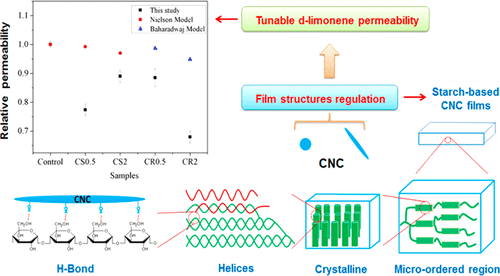当前位置:
X-MOL 学术
›
J. Agric. Food Chem.
›
论文详情
Our official English website, www.x-mol.net, welcomes your
feedback! (Note: you will need to create a separate account there.)
Tunable d-Limonene Permeability in Starch-Based Nanocomposite Films Reinforced by Cellulose Nanocrystals
Journal of Agricultural and Food Chemistry ( IF 5.7 ) Pub Date : 2018-01-22 00:00:00 , DOI: 10.1021/acs.jafc.7b05457 Siyuan Liu 1 , Xiaoxi Li 1 , Ling Chen 1 , Lin Li 1, 2 , Bing Li 1 , Jie Zhu 2
Journal of Agricultural and Food Chemistry ( IF 5.7 ) Pub Date : 2018-01-22 00:00:00 , DOI: 10.1021/acs.jafc.7b05457 Siyuan Liu 1 , Xiaoxi Li 1 , Ling Chen 1 , Lin Li 1, 2 , Bing Li 1 , Jie Zhu 2
Affiliation

|
In order to control d-limonene permeability, cellulose nanocrystals (CNC) were used to regulate starch-based film multiscale structures. The effect of sphere-like cellulose nanocrystal (CS) and rod-like cellulose nanocrystal (CR) on starch molecular interaction, short-range molecular conformation, crystalline structure, and micro-ordered aggregated region structure were systematically discussed. CNC aspect ratio and content were proved to be independent variables to control d-limonene permeability via film-structure regulation. New hydrogen bonding formation and increased hydroxypropyl starch (HPS) relative crystallinity could be the reason for the lower d-limonene permeability compared with tortuous path model approximation. More hydrogen bonding formation, higher HPS relative crystallinity and larger size of micro-ordered aggregated region in CS0.5 and CR2 could explain the lower d-limonene permeability than CS2 and CR0.5, respectively. This study provided new insight for the control of the flavor release from starch-based films, which favored its application in biodegradable food packaging and flavor encapsulation.
中文翻译:

纤维素纳米晶体增强的淀粉基纳米复合薄膜中的可调d-柠檬烯通透性
为了控制d-柠檬烯的渗透性,纤维素纳米晶体(CNC)用于调节淀粉基薄膜的多尺度结构。系统地讨论了球形纤维素纳米晶体(CS)和棒状纤维素纳米晶体(CR)对淀粉分子相互作用,短程分子构象,晶体结构和微观有序聚集区域结构的影响。事实证明,CNC长径比和含量是通过薄膜结构调节来控制d-柠檬烯渗透性的独立变量。新的氢键形成和羟丙基淀粉(HPS)相对结晶度增加可能是降低d的原因-li烯的渗透性与曲折路径模型的近似值相比。CS0.5和CR2中更多的氢键形成,更高的HPS相对结晶度和较大的微有序聚集区域尺寸可以解释分别比CS2和CR0.5更低的d-柠檬烯渗透性。这项研究为控制淀粉基薄膜中的香料释放提供了新的见识,这有利于其在生物可降解食品包装和香料封装中的应用。
更新日期:2018-01-22
中文翻译:

纤维素纳米晶体增强的淀粉基纳米复合薄膜中的可调d-柠檬烯通透性
为了控制d-柠檬烯的渗透性,纤维素纳米晶体(CNC)用于调节淀粉基薄膜的多尺度结构。系统地讨论了球形纤维素纳米晶体(CS)和棒状纤维素纳米晶体(CR)对淀粉分子相互作用,短程分子构象,晶体结构和微观有序聚集区域结构的影响。事实证明,CNC长径比和含量是通过薄膜结构调节来控制d-柠檬烯渗透性的独立变量。新的氢键形成和羟丙基淀粉(HPS)相对结晶度增加可能是降低d的原因-li烯的渗透性与曲折路径模型的近似值相比。CS0.5和CR2中更多的氢键形成,更高的HPS相对结晶度和较大的微有序聚集区域尺寸可以解释分别比CS2和CR0.5更低的d-柠檬烯渗透性。这项研究为控制淀粉基薄膜中的香料释放提供了新的见识,这有利于其在生物可降解食品包装和香料封装中的应用。











































 京公网安备 11010802027423号
京公网安备 11010802027423号